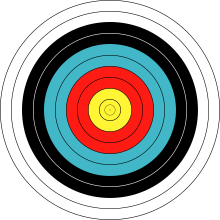

The bullseye or bull's eye has, since 1833,[1] been the name for the center of a target and, by extension, since 1857,[1] has been given to any throw, toss, or shot that hits the center.
In a further development, success in an endeavor in which there is such inherent difficulty that most people are far more likely to choose, do, or identify something that is either unfortunately only close to or dismissively far from the ideal or necessary thing to choose can be called "hitting the bull's eye."
The term "bullseye" had been used since the Middle Ages to describe a hole, in particular where the breadth and thickness of the object was much larger than the hole.[2] In this sense, it was commonly used to describe the pontil mark on medieval crown-glass windows, where a blob (bullion, from the French boule) of molten glass was attached to a pole and spun rapidly to flatten it out into a large disk, from which windows were cut. The center was much thicker with a small divot where the pole was attached, and this was referred to as the bullseye. The bullseye was too thick for making windows, but often used for making crown-glass lenses or deck prisms in ships, to let in light to the hold below deck, and these were also called bullseyes. By extension, police lanterns with lenses for focusing light into a spot became known as bullseyes. This thick glass was also called the crown, and the term bullseye became a slang term to refer to the British crown coin. Its use to describe the center of a target was first recorded in 1833 according to the Oxford English Dictionary, or possibly as early as 1813 according to other sources.[3][4]
In some archery traditions, the term "gold" is used in preference to "bullseye". In target archery, hitting the center ring of an international target is worth 10 points, or 9 points if it's an Imperial target.
In Japanese archery, known as Kyūdō, the bullseye is called "zuboshi".[5] The term is also used as idiomatic slang just as it is in English, to note that someone has done or said something that hits "right on the nose."
In darts, the bullseye is located 5 foot 8 inches (1.73m) above the floor.[6] Before the start of a match players will usually throw closest to the bullseye to decide who has the advantage of throwing first. An inner bullseye (sometimes referred to as a "double bullseye" in amateur play) is a smaller, inner circle and counts for 50 points while an outer bull is worth 25 points.[7] In the World Grand Prix, which has a double start format, an inner bullseye can begin a leg. In the dart golf game, the bullseye is used as part of a three-part tie breaker that also includes the treble twenty.
Hitting three bullseyes in darts is known as the "Alan Evans shot".[8]
YouTube Encyclopedic
-
1/1Views:2 741
-
Bullseye Camera Systems Target Camera - NRA Show 2017
Transcription
See also
- Bullseye (shooting competition)
- Roundel, a round shape in heraldry
- Bullseye, a British game show based on darts
- Porthole
References
- ^ a b "bulls-eye | Origin and meaning of bulls-eye by Online Etymology Dictionary". www.etymonline.com. Retrieved 2019-12-03.
- ^ "Bulls-eye | Etymology of bulls-eye by etymonline".
- ^ Sandbows and Blacklights, Reflections on Optics by Stephan R. Wilks -- Oxford University Press 2021 Page 88
- ^ A Dictionary of the English Language - Volume 1, Part 1 by Samuel Johnson, Robert Gordon Latham, Henry John Todd -- longmans, Green & Co. 1866 Page 314
- ^ "Zuboshi definition on Wiktionary". en.wiktionary.org. Retrieved 2020-04-26.
- ^ "Dart Board Regulations - Dartboard Height Measurements".
- ^ Osgood, Rick. "Darts Basics – Rules, Tips, Equipment, How to Hang a Dartboard, Measurements". Cyber Darts. Retrieved 4 January 2009.
- ^ Edwards, Dave (6 January 2011). "Darts: Sporting giants face-off". Wales Online. Retrieved 4 January 2014.
